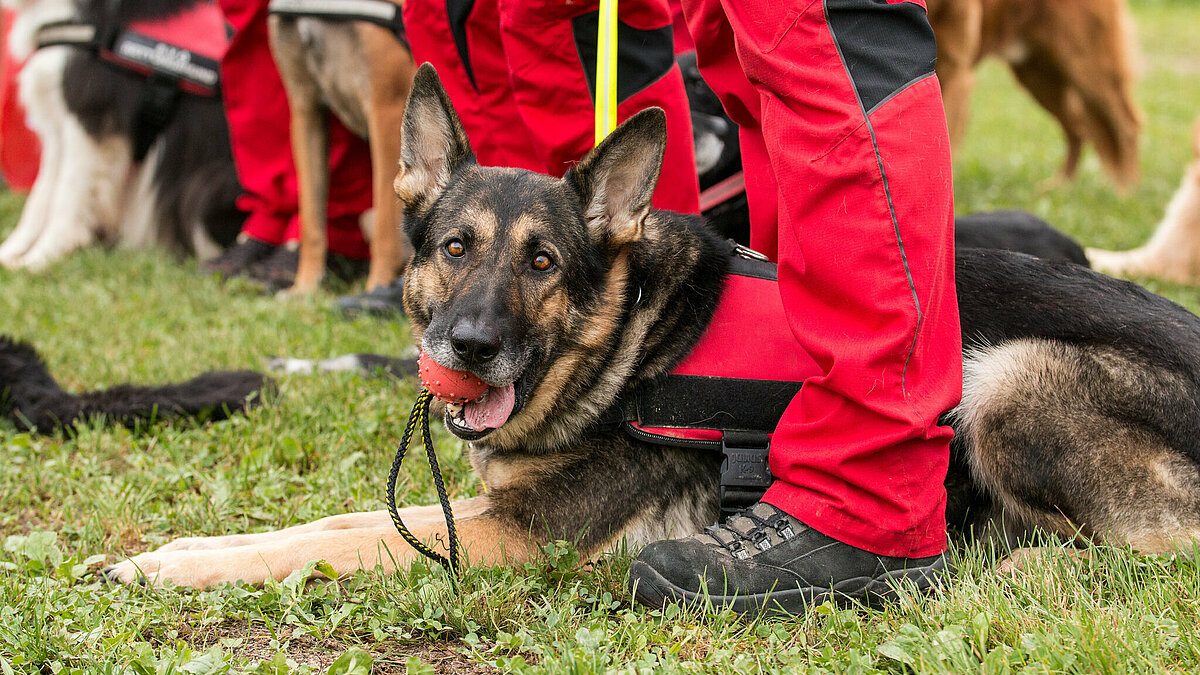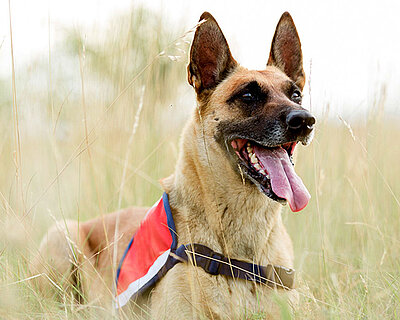
Facts about the search and rescue dog
Open-minded, obedient & eager to learn.
Basically, almost every dog can be trained as a search and rescue dog, regardless of breed. It must be healthy, resilient, willing to learn, interested in solving tasks and have strong nerves. In addition, the dog should be of medium size and not too heavy in weight, as it must be carried by its handler in some places.
Search and rescue dog work is teamwork.
Together with its handler, the search and rescue dog forms a well-coordinated team. Mutual support and trust during training and in case of an emergency are vital in search and rescue dog work. The dog handler must be physically and mentally resilient, have empathy for the dog, be ready for deployment and a team player, and be able to interpret the dog's body language correctly. Expertise in first aid for humans and dogs as well as operational logistics are also required.
Training to save lives.
Mission teams trained by the IRO have completed two to three years of intensive training – both the dogs and their handlers. Young dogs start playfully with easy search and alert exercises, while experienced dogs must face complex scenarios in terms of nose and obedience work as well as dexterity. Latter is the ability of the dog to move calmly on difficult ground, which may also be unstable, and to overcome obstacles independently.
600 training hours per year.
Search and rescue dog work is a time-consuming but fulfilling voluntary work. On average, up to 50 hours of training are required in some months to maintain a high educational level. The training of the dogs often begins at the age of eight weeks. The cost of training a single search and rescue dog for at least two years amounts to about 20,000 Euros.
Leisure time of search and rescue dogs.
In their free time, dogs may be dogs: long walks in the countryside, digging holes in the sand, swimming or lying lazily in the sun and doing nothing at all. Of course, they are also kept busy on a small scale, they demand that. But the basic rule is leisure time must remain leisure time and the dogs should be able to rest. A healthy balance between work and rest is very important, especially for search and rescue dogs.
220 million olfactory cells.
Dogs possess about 40 times the number of olfactory cells compared to humans and are therefore irreplaceable helpers in the search for missing persons or the rescue of buried persons due to their distinctive sense of smell. With about 220 million olfactory cells, an experienced avalanche or rubble search dog can locate and indicate people up to ten meters deep. A trained area search dog can detect human scent up to 200 metres away. It is therefore far superior to modern technology and to humans.
Prompt assistance.
When accidents or catastrophes happen, and people get into trouble, professionally trained search and rescue dog teams are often the only hope. In most cases, the assignments involve searches for people who got lost – usually elderly people, demented or suicidal persons, or children. While human search units need several hours to search a large area, the dog sometimes only needs a few minutes to find the missing person thanks to its fine nose.
6 disciplines, 1 goal – save lives.
IRO trains search and rescue dogs in the disciplines Tracking, Area Search, Rubble Search, Avalanche Search, Water Rescue and Mantrailing.
Mission-ready 365 days a year.
The 126 member organisations of the International Search and Rescue Dog Organisation are on 24-hour standby, 365 days a year.
Well-deserved retirement.
With age, as with humans, the efficiency decreases, and age-related limitations become apparent. Here, it is the dog handler’s responsibility to use the dog according to its age-related and physical condition or to withdraw the dog from missions and let him work only in training, dosed and age appropriate. It is important not to take the dogs out of work at once. The task as a search and rescue dog is and was always their life and just like a top athlete they must train down or be employed according to their age.
Donate right now,
because every contribution can help save lives.

